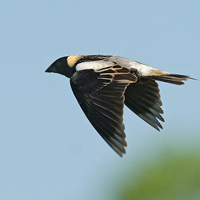Bobolink
Scientific name: Dolichonyx oryzivorus



Cover photos credit: George K. Peck (all photos)
Status
Threatened
“Threatened” means the species lives in the wild in Ontario, is not endangered, but is likely to become endangered if steps are not taken to address factors threatening it.
Date added to the Species at Risk in Ontario List
September 28, 2010
Read the most recent assessment report [PDF]
What it looks like
The Bobolink is a medium sized songbird found in grasslands and hayfields. In their summer breeding season, male Bobolinks are black with a white back and yellow collar. By late summer, males lose their breeding plumage to resemble the female’s tan colour with black stripes.
Bobolinks spend much of their time out of sight on the ground feeding on insects and seeds. They seem to appear out of nowhere and can be spotted flying in the sky or over the tops of vegetation singing a bubbling musical song.
Where it lives
Historically, Bobolinks lived in North American tallgrass prairie and other open meadows. With the clearing of native prairies, Bobolinks moved to living in hayfields.
Bobolinks often build their small nests on the ground in dense grasses. Both parents usually tend to their young, sometimes with a third Bobolink helping.
Where it’s been found in Ontario
The Bobolink breeds across North America. In Ontario, it is widely distributed throughout most of the province south of the boreal forest. In southern Ontario, its range extends from Windsor north to Sault Ste. Marie, and east to Cornwall.
Bobolinks are most common in:
- Bruce/Grey/Dufferin region
- Kawartha Lakes and Peterborough region
- between Belleville and Kingston
- between the Ottawa and St. Lawrence rivers
Bobolinks may also be found in scattered populations farther north where suitable habitat exist, including:
- Timiskaming and Cochrane Districts in the northeast
- Thunder Bay, Rainy River and Dryden areas in northwestern Ontario
What threatens it
Bobolink populations have declined considerably over the past half century. As a wide-ranging species that migrates in and out of Ontario, there are likely several causes for this decline.
Habitat loss and degradation are considered the greatest threats to Bobolink populations.
Along their migration route and in their wintering areas in South America, they are considered a pest of grain crops.
Mowing of hay during the breeding period may inadvertently kill and disturb nesting adults and young birds and destroy eggs and nests.
Cutting hay in early to mid July coincides with the time that young birds are in the nest and are not able to fly.
In addition, the quality of Bobolink nesting habitat has likely declined over time due to modern hay production practices such as earlier maturing seed mixtures and shorter crop rotation cycles.
Overall, we need to know more about the threats to Bobolink in this province.
Action we are taking
This species and its habitat are protected under Ontario’s Endangered Species Act, 2007 (ESA).
The ESA also requires us to prepare recovery guidance for threatened species such as Bobolink.
All species listed on the Species at Risk in Ontario List may be eligible for consideration for government funding through the Species at Risk Stewardship Program.
Regulatory exemptions for Bobolink
Section 4.1 of Ontario Regulation 242/08 sets out a regulatory exemption that allows agricultural operations to continue where Bobolink occurs on the landscape.
Other activities impacting Bobolink or its habitat may be eligible for a conditional exemption under Part IV of Ontario Regulation 830/21, which includes an option to pay a charge into the Species at Risk Conservation Fund.
Recovery strategy
A recovery strategy forms the foundation of scientific advice to government on ways to ensure healthy numbers of a species return to Ontario.
Read the Bobolink recovery strategy’s executive summary (May 31, 2013) [PDF]
Read the full Bobolink recovery strategy (May 31, 2013) [PDF]
Government response statement
A government response statement outlines the actions the government intends to take or support to help recover the species.
Read the Bobolink government response statement (December 15, 2015)
Review of progress
A review of progress made toward protecting and recovering a species is required no later than the time specified in the species’ government response statement, or not later than five years after the government response statement is published if no time is specified.
Read the report on progress towards the protection and recovery of four species at risk, including Bobolink (2020).
Habitat protection
General habitat descriptions are technical, science-based documents that provide greater clarity on the area of habitat protected for a species.
Read the general habitat description (July 2, 2013)
Species at Risk Conservation Fund
Bobolink has been designated as an eligible species for the Species at Risk Conservation Fund.
Learn more about how the Species at Risk Conservation Fund and the Species Conservation Action Agency is working to help protect and recover conservation fund species.
What you can do
Report a sighting
Submit your observations of species at risk to the Natural Heritage Information Centre (NHIC), which is Ontario’s conservation data centre. Join the (NHIC) "Rare Species of Ontario" project in iNaturalist to make submitting your observations quick and easy.
Volunteer
Volunteer with your local nature club or provincial park to participate in surveys or stewardship work focused on species at risk.
Be a good steward
Private landowners have a very important role to play in species recovery. If you find a Bobolink nesting on your land, you may be eligible for stewardship programs that support the protection and recovery of species at risk and their habitats, such as the Species at Risk Stewardship Program.
As with all wildlife, don’t disturb or harass the birds or nesting sites. Be respectful and observe from a distance.
Report illegal activity
Report any illegal activity related to plants and wildlife to
Quick facts
- During migration, Bobolinks have been known to travel up to 1,800 km in a single day.
- Bobolinks can be beneficial in hayfields since they eat large numbers of insects that could otherwise be harmful to crops.